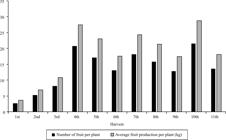Abstract:
The objective of this work was to select cupuaçu (Theobroma grandiflorum) tree progenies and individuals based on their agronomic traits, and, indirectly, to identify those adapted to an agroforestry system (AFS) environment in the Brazilian Amazon. For this purpose, 25 full-sib progenies were planted and tested in consortium with black pepper (Piper nigrum), banana (Musa spp.), and bacuri (Platonia insignis) trees. The experiment was carried out in a randomized complete block design, with five replicates and three plants per plot, from 2005 to 2019. For the statistical analyses, the phenotypic averages for production and incidence of witches’ broom disease, evaluated during 11 harvests, were used. Superior progenies and individuals were identified using the mixed model methodology (REML/BLUP), which led to the selection of ten plants from five families with superior agronomic traits. Cupuaçu tree progenies 6, 36, 37, 49, and 52 are the ones that best adapt to the environment of a multispecies AFS in the Amazon region because of their agronomic traits under competitive conditions. Ten matrices show agronomic potential and indirect adaptation to the AFS and can be used as clonal cupuaçu cultivars in this environment.
Index terms:
Theobroma grandiflorum; fruit tree breeding; genetic selection; REML/BLUP

 Thumbnail
Thumbnail
 Thumbnail
Thumbnail

